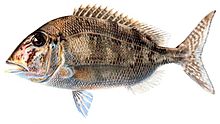鯛
Hello, you have come here looking for the meaning of the word 鯛. In DICTIOUS you will not only get to know all the dictionary meanings for the word 鯛, but we will also tell you about its etymology, its characteristics and you will know how to say 鯛 in singular and plural. Everything you need to know about the word 鯛 you have here. The definition of the word 鯛 will help you to be more precise and correct when speaking or writing your texts. Knowing the definition of鯛, as well as those of other words, enriches your vocabulary and provides you with more and better linguistic resources.
See also: 鲷
| ||||||||
Translingual
Han character
鯛 (Kangxi radical 195, 魚+8, 19 strokes, cangjie input 弓火月土口 (NFBGR), four-corner 27320, composition ⿰魚周)
References
- Kangxi Dictionary: page 1472, character 18
- Dai Kanwa Jiten: character 46226
- Dae Jaweon: page 2004, character 27
- Hanyu Da Zidian (first edition): volume 7, page 4697, character 18
- Unihan data for U+9BDB
Chinese
| trad. | 鯛 | |
|---|---|---|
| simp. | 鲷 | |
Glyph origin
Phono-semantic compound (形聲 / 形声, OC *tɯːw) : semantic 魚 (“fish”) + phonetic 周 (OC *tjɯw).
Pronunciation
- Mandarin
- (Standard Chinese)+
- Hanyu Pinyin:
- Zhuyin: ㄉㄧㄠ
- Tongyong Pinyin: diao
- Wade–Giles: tiao1
- Yale: dyāu
- Gwoyeu Romatzyh: diau
- Palladius: дяо (djao)
- Sinological IPA (key): /ti̯ɑʊ̯⁵⁵/
- (Standard Chinese)+
- Cantonese
- (Standard Cantonese, Guangzhou–Hong Kong)
- Jyutping: diu1
- Yale: dīu
- Cantonese Pinyin: diu1
- Guangdong Romanization: diu1
- Sinological IPA (key): /tiːu̯⁵⁵/
- (Standard Cantonese, Guangzhou–Hong Kong)
- Middle Chinese: tew
- Old Chinese
- (Zhengzhang): /*tɯːw/
Definitions
鯛
Synonyms
Compounds
References
- “鯛”, in 漢語多功能字庫 (Multi-function Chinese Character Database), 香港中文大學 (the Chinese University of Hong Kong), 2014–
Japanese
| Shinjitai | 鯛 | |
| Kyūjitai [1] |
鯛󠄁 鯛+ 󠄁?(Adobe-Japan1) |

|
| 鯛󠄄 鯛+ 󠄄?(Hanyo-Denshi) (Moji_Joho) | ||
| The displayed kanji may be different from the image due to your environment. See here for details. | ||
Kanji
鯛
Readings
- Go-on: ちょう (chō)←てう (teu, historical)
- Kan-on: ちょう (chō)←てう (teu, historical)
- Kun: たい (tai, 鯛)←たひ (tafi, 鯛, historical)
Etymology
| Kanji in this term |
|---|
| 鯛 |
| たい Jinmeiyō |
| kun'yomi |
/tapi1/ → /tapi/ → /tafi/ → /tai/
From Old Japanese.
Pronunciation
Noun
鯛 or 鯛 • (tai) ←たひ (tafi) or タヒ (tafi)?
- sea bream (fish of the family Sparidae); porgy
- , text here
- 醤酢尓蒜都伎合而鯛願吾尓勿所見水䓗乃煮物 [Man'yōgana]
- 醤酢に蒜搗きかてて鯛願ふ我れにな見えそ水葱の羹 [Modern spelling]
- hishio-su ni hiru tsukikatete tai-negau ware ni na mi(s)e so nagi no atsumono
- Don't show a fellow who's begging for a nice sea bream all fixed with bean paste, with vinegar and pounded garlic, such a thing as water-leek soup![4]
- , text here
- specifically, the 真鯛 (mada, “red sea bream”)
Derived terms
Derived terms
- 鯛島 (taijima)
- 鯛焼, 鯛焼き (taiyaki)
- 赤魚鯛 (akō-dai)
- 甘鯛 (amadai, “tilefish”)
- 石鯛 (ishidai)
- 一等鯛 (ittō-dai)
- 糸撚鯛 (itoyori-dai)
- 疣鯛 (ibodai, “Japanese butterfish”)
- 烏帽子鯛 (eboshi-dai, “man-of-war fish”)
- 寒鯛 (kandai)
- 黄鯛 (kidai)
- 狐鯛 (kitsunedai)
- 巾着鯛 (kinchaku-dai)
- 金時鯛 (kintoki-dai)
- 金目鯛, 金眼鯛 (kinmedai)
- 銀目鯛, 銀眼鯛 (ginmedai)
- 黒鯛 (kurodai, “black porgy”)
- 瘤鯛 (kobudai)
- 桜鯛 (sakuradai)
- 雀鯛 (suzumedai)
- 千年鯛 (sennen-dai)
- 鷹の羽鯛 (taka no hadai)
- 血鯛 (chidai)
- 茅渟鯛 (chinudai)
- 天竺鯛 (tenjiku-dai)
- 仁座鯛 (nizadai)
- 浜鯛 (hamadai)
- 姫鯛 (himedai)
- 笛鯛 (fuedai)
- 笛奴鯛 (fue-yakko-dai)
- 武鯛, 不鯛 (budai)
- 平鯛 (hedai)
- 真鯛 (madai)
- 的鯛 (matōdai, “John Dory”)
Idioms
See also
Proper noun
- a surname
References
- ^ “鯛”, in 漢字ぺディア [Kanjipedia] (in Japanese), The Japan Kanji Aptitude Testing Foundation, 2015–2024
- ^ NHK Broadcasting Culture Research Institute, editor (1998), NHK日本語発音アクセント辞典 [NHK Japanese Pronunciation Accent Dictionary] (in Japanese), Tokyo: NHK Publishing, Inc., →ISBN
- ^ Matsumura, Akira, editor (2006), 大辞林 [Daijirin] (in Japanese), Third edition, Tokyo: Sanseidō, →ISBN
- ^ Edwin A. Cranston (1998) The Gem-Glistening Cup, illustrated edition, Stanford University Press, →ISBN, page 281
Korean
Etymology
(This etymology is missing or incomplete. Please add to it, or discuss it at the Etymology scriptorium. Particularly: “Middle Korean readings, if any”)
Pronunciation
- (SK Standard/Seoul) IPA(key):
- Phonetic hangul:
Hanja
鯛 • (jo) (hangeul 조, revised jo, McCune–Reischauer cho, Yale co)
Vietnamese
Han character
- This term needs a translation to English. Please help out and add a translation, then remove the text
{{rfdef}}.
References
- Thiều Chửu : Hán Việt Tự Điển Hà Nội 1942
- Trần Văn Chánh: Từ Điển Hán Việt NXB Trẻ, Ho Chi Minh Ville, 1999
- Vũ Văn Kính: Đại Tự Điển Chữ Nôm, NXB Văn Nghệ, Ho Chi Minh Ville, 1999


